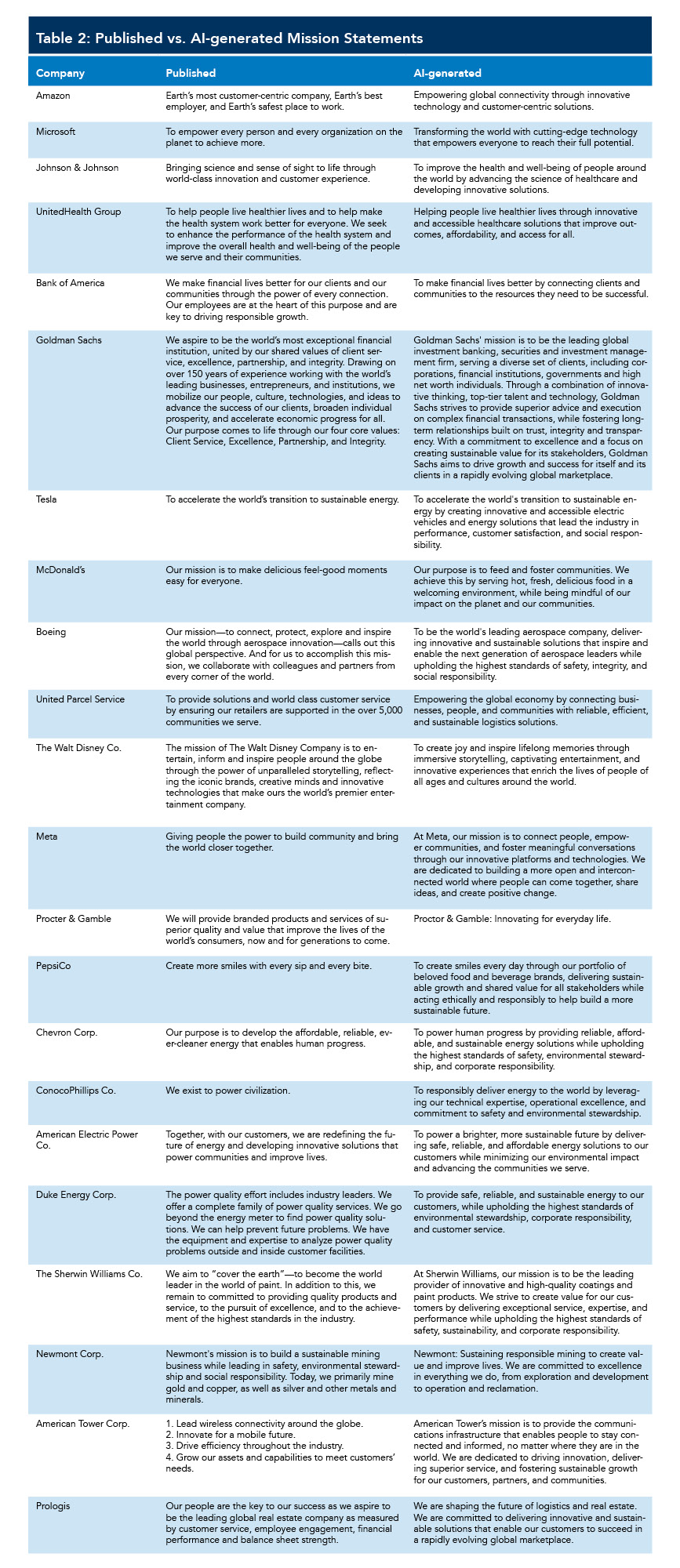Mission statements are a North Star for businesses—a declaration of who they are, what they do, and why they exist. Of course, developing these statements is a collaborative commitment that can exhaust time and resources across the enterprise.
So, what if companies used AI to speed up the process? Could AI-generated mission statements—crafted in a matter of seconds—transform how a company defines and outlines its core vision? We took steps to find out.
Looking for an AI Advantage
First, we gathered the mission statements of the top 22 companies from the S&P 500. Then we generated new statements for those 22 companies via ChatGPT, comparing them to their original counterpart. From there, we surveyed 200 business professionals in the United States to determine which statements they preferred (see the appendix at the end of this article for methodology and survey construction).
The result: Respondents gave a slight edge to machines, with about 54% favoring the AI-generated mission statements. However, a deeper data breakdown revealed nuances. Business professionals who are male or have bachelor or graduate degrees overwhelmingly preferred human-generated mission statements. And factors such as job functions and responsibilities also affected preferences. For example, those working in accounting and finance fields chose man-made mission statements by a significant margin.
Preferences also varied by industry (see Table 1). Eight industries favored AI-generated mission statements: technology, healthcare, financials, consumer discretionary, consumer staples, energy, utilities, and materials. The other three industries—industrials, communication services, and real estate—gravitated to human-made mission statements.

This research—the first that explores AI-generated mission statements (to the best of our knowledge)—speaks to a critical overlap between strategy and tech innovation. For organizations, it’s more important than ever to invest in strategic planning. And in a hypercompetitive business environment, companies are looking for any edge that tech can provide.
Speed vs. Intellect
Computer-generated mission statements still have limited comprehension regarding the context and meaning of many user prompts. So, in certain industries, AI-generated mission statements might fall short of helping business professionals actually grasp an organization’s vision. However, ChatGPT’s natural language processing capabilities still offer a promising and enticing tool for professionals looking to improve efficiency in organizational strategy planning.
The sample mission statements we collected from the top 22 S&P 500 companies represented 11 industries. Having a strong mix of sectors was just one of many variables we sought to ensure a thorough test of ChatGPT. Another variable was length—from a one-sentence mission statement to a one-paragraph purpose. We also used various prompts when interacting with ChatGPT to make sure that the AI-generated mission statements were comparable in length. For instance, in the case of McDonald’s, we prompted ChatGPT to “create a new short memorable mission statement for McDonald’s.” Similar prompts were used for other companies, including:
1. Create a new short impactful mission statement for _______.
2. Create a new short (2-3 sentence) mission statement for _______.
3. Create a new memorable mission statement for _______.
4. Create a new impactful mission statement for _______.
It’s worth noting that ChatGPT’s responses are virtually instantaneous, taking less than 10 seconds to generate a new mission statement for the organizations. Despite the time-saving edge, ChatGPT-generated mission statements were quite repetitive across industries, with largely monotonous use of shallow and generic wording. For example, when entering the prompt to create a mission statement for Disney, ChatGPT’s response included “With a focus on sustainability and social responsibility, we aim to make a positive impact on our communities and the planet. We believe that by leveraging our resources and expertise, we can drive positive change and make a meaningful difference in the world.” However, in the next prompt to create a mission statement for Boeing, ChatGPT’s response included “With a focus on sustainability and social responsibility, we aim to make a positive impact on our communities and the planet. We believe that by leveraging our expertise and resources, we can help to address global challenges and create a better world for future generations.”
We noticed throughout entering prompts into ChatGPT that in order to create a slightly more distinct and diverse mission statement, users had to enter different commands, such as “create a short mission statement” or “create an interesting and unique mission statement.” These nuances required the user to critically examine the output of ChatGPT. We also found that ChatGPT lacked the nuances of each company. The generic mission statements seem to follow a specific length, and originality and creativity seem to be lost in this process.
Table 2 shows 22 pairs of man-made and machine-driven mission statements.
Machines Have Much More to Learn
In today’s disruptive business environment, future-focused companies might find the need to reassess their strategies and vision. That could include revising their mission statements. As business professionals continue leaning into tech tools to support their work, it’s logical for companies and their leaders to consider turning to AI to rewrite those statements.
However, although AI can be useful and efficient, the technology still has limitations. Our research indicates that machines can provide a solid starting point for mission statement ideation, but humans still need to lead the process. Companies should leave strategy in the hands of trained business professionals—trusting their business acumen and experience.
Appendix: Methodology and Survey Construction
For our survey, we used Prolific, a crowdsourcing website. It provided access to business professionals from different industries in the S&P 500. It also provided unique identifiers to respondents that ensured that we captured distinct responses and allowed us to link respondents in case we employ a similar or follow-up survey in the future. In selecting our pool of survey participants, we limited the sample to business professionals working in the U.S. who have financial, accounting, and upper managerial responsibilities. We also required them to be involved in the business strategy and decision-making processes of their companies.
The demographic breakdown of our respondents was:
· Gender: Nearly 75% were male, about 25% were female, and less than 1% percent identified as nonbinary.
· Race: Approximately 86% were white, 6% were Black, 8% were Asian, and less than 1% were Native Hawaiian, Native American, and others.
· Education: More than 53% obtained bachelor’s degrees, about 34% held graduate degrees, and 12% had high school or some college-equivalent education.
The professional roles and responsibilities breakdown for respondents were:
· 80% middle management
· About 17% C-suite
· About 70% have a finance or accounting role
· More than 50% work in a company with more than 2,000 employees
· About 36% work in companies with fewer than 1,000 employees
· 13% work in companies with 1,000 to 2,000 employees




